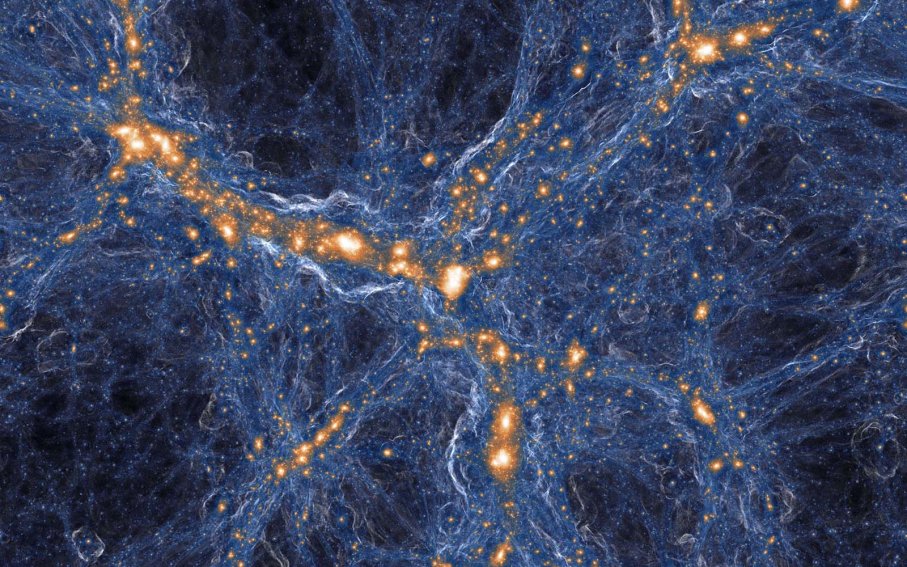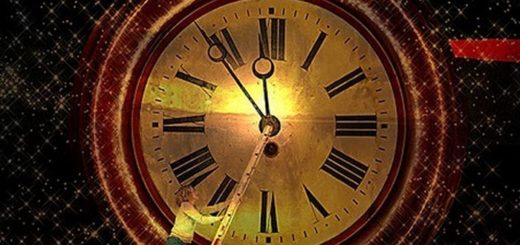Scientists Build Universe to Understand How Black Holes Kill Galaxies

This image comes courtesy of the IllustrisTNG collaboration, an ambitious project that’s bent on simulating how galaxies form. This IllustrisTNG visualization shows shock waves in collapsed dark matter structures (orange/white). WU, HAHN, WECHSLER, ABEL (KIPAC)/NASA/TNG COLLABORATION
Supermassive black holes are an intrinsic component of most galaxies in our universe, but astronomers aren’t quite sure how they originate and how they influence galactic evolution. Their impacts, however, are clear. Observations suggest that these supermassive behemoths have the power to stimulate star formation in their host galaxies — or stop it cold.
To understand how supermassive black holes evolve and how they impact galaxy formation, astrophysicists are increasingly turning to complex cosmological models simulated by some of the world’s most powerful supercomputers. The results of one such model have been published in a trio of papers, and it could be the key to understanding some of the biggest mysteries hanging over modern astrophysics.
The Dark (Matter) Web
Resembling a vast three-dimensional web, the cosmos is shaped by dark matter. This invisible “stuff” makes up 84.5 percent of all the mass in the universe and yet it doesn’t interact with electromagnetic radiation (i.e., light). Thought to be composed of nonbaryonic particles, this stuff does have a gravitational effect that we can indirectly observe, however. We know it’s out there, we just can’t see it.
Because there’s so much dark matter, it dominates gravitational interactions, clumping together, corralling islands of “normal” matter. These islands form massive clusters of galaxies that are connected by filaments of dark matter that are themselves threaded with galaxies, like shiny beads along an invisible string.
Since dark matter literally shapes the cosmos, it must take center stage in any large-scale simulation of the universe.
Creating a Virtual Universe
In the most ambitious cosmic simulation of its kind, an international team of scientists have created their own universe inside a computer to better understand the large-scale structure of the cosmos. It’s called the “Illustris–The Next Generation” (IllustrisTNG) project. The simulation relies on the basic laws of physics and shows how the cosmic web of dark matter has evolved and shaped our universe since the Big Bang.
Scientists built IllustrisTNG using a powerful code called AREPO that they ran on Germany’s fastest mainframe computer, the Hazel Hen machine. The project is the largest hydrodynamic simulation to date and can model the emergence of cosmic structures, according to a statement. One of the two simulation runs, which used over 24,000 processors, took two months to complete and modeled the formation of millions of galaxies in a simulated volume measuring one billion light-years wide.
In short, the researchers threw the ingredients of the universe into a virtual box and let the known laws of physics bake a cosmic cake. And the results are stunning. See for yourself in the video:
“The new simulations produced more than 500 terabytes of simulation data. Analyzing this huge mountain of data will keep us busy for years to come, and it promises many exciting new insights into different astrophysical processes,” said principal investigator Volker Springel, of Heidelberg University, Germany.
How Black Holes Kill
In one of the three related studies published in the journal Monthly Notices of the Royal Astronomical Society, the impact of black holes on galactic evolution was demonstrated.
Star-forming galaxies, also known as “starburst” galaxies, are dominated by the bright, blue light of young stars erupting to life. As time goes on, however, star formation is dramatically switched off, leaving only old red stars to dominate the dying galaxies (known as “red and dead” galaxies). Astronomers have been trying to better understand what causes star formation to switch off and now, with the help of IllustrisTNG, the researchers are hopeful that this simulated universe may reveal the black hole mechanism that can control the fertility of entire galaxies.
“The only physical entity capable of extinguishing the star formation in our large elliptical galaxies are the supermassive black holes at their centers,” said Dylan Nelson, of the Max Planck Institute for Astrophysics in Garching, Germany. “The ultrafast outflows of these gravity traps reach velocities up to 10 percent of the speed of light and affect giant stellar systems that are billions of times larger than the comparably small black hole itself.”
Theoretical simulations of the universe can help to explain real observations of the cosmos. With IllustrisTNG, astrophysicists have gained a powerful new tool to better understand mysterious phenomena and, perhaps, uncover new puzzles about our ever-expanding universe.



 Creators of mankind
Creators of mankind Description of “Tall white aliens”
Description of “Tall white aliens” Where they came from?
Where they came from? About hostile civilizations
About hostile civilizations The war for the Earth
The war for the Earth “Tall white aliens” about eternal life
“Tall white aliens” about eternal life Video: “Nordic aliens”
Video: “Nordic aliens” Aliens
Aliens Alien encounters
Alien encounters The aliens base
The aliens base UFO
UFO Technology UFO
Technology UFO Underground civilization
Underground civilization Ancient alien artifacts
Ancient alien artifacts Military and UFO
Military and UFO Mysteries and hypotheses
Mysteries and hypotheses Scientific facts
Scientific facts


















